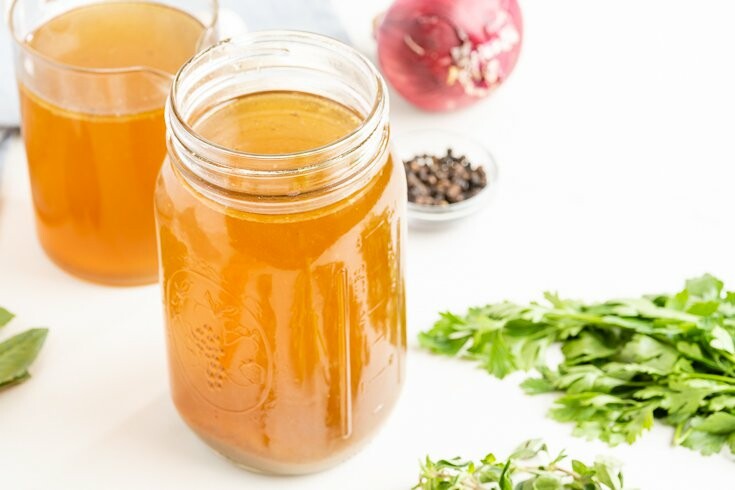
What makes bone broth good for you?
The nutritional profile of bone broth depends widely on the kind of bones you use (you can use chicken, turkey, beef, pork, fish—anything!), your cooking time, and the way the animals were raised (grass-fed and pasture-raised animals will give you more nutrient density). But there are a few common things about bone broth that make it so awesome:
- It’s loaded with gelatin. The slow and low cooking helps to release the gelatin—which is a broken-down version of collagen—that is in the connective tissues and bones you use. Why is this a good thing? Well, major important areas of our body (like the lining of our gut and our own connective tissues and joints) are made from collagen—in fact, about 25% of our body is made of collagen! Some folks use gelatin or collagen supplements, but bone broth is another effective (and affordable) way to get your gelatin and collagen. Making sure you get an adequate supply of collagen has a ton of health benefits like helping you sleep better, making your skin more supple, protecting your gut lining, and making your joints less achy.
- It’s easy to digest. Sometimes the roughage of a huge salad is good for you, but sometimes—especially if you are fighting digestive disorders or your immune system isn’t up to snuff—easy-to-digest foods are the way to go. Bone broth is a wonderful marriage of easy-to-digest but still nutritionally powerful
Is bone broth some new fancy food trend?
While bone broth is quite trendy now, it is absolutely not a new food! Healing broths and stocks have been part of the vast majority of cultures for centuries. Chances are if you can speak with an elder in your community, they can tell you stories about healing bone broth and soups from their childhood. If you’d like to read more about traditional foods and how they are (unfortunately) missing from our current diets, I highly recommend checking out Nourishing Traditions by Sally Fallon. It’s an incredibly eye-opening look into how we’ve stripped away the traditional preparation methods for many of our foods in the interest of saving-time.
How to do you make bone broth?
While bone broth can be incredibly time-consuming to make (three hours at it’s fastest in your Instant Pot or up to two days using other methods), it is also incredibly simple. To make bone broth, all you have to do is:
- Cook or roast animal bones.
- Soak shortly in filtered water and apple cider vinegar.
- Add any seasonings or flavorings you prefer.
- Cook over very low heat until done. That’s it!
The vast majority of the bone broth cooking time is hands-off (we’re talking like 99% of the time).
How do you use bone broth?
You can use bone broth just like you would any other stock or broth. Use it to make chicken soup. Use it to cook rice. Use beef bone broth it in beef stew. Many bone broth fans also prefer to drink bone broth straight—as a sipping broth. The long-simmering of the broth gives it a complex, rich flavor that is cozy, comforting, and warm. I personally love having bone broth with ginger and garlic for immune supporting qualities! The gelatin in the broth is great for your skin and joints!
What are the best bones for bone broth?
I believe the best bones for bone broth are the ones you have! I always make bone broth after roasting a chicken—because those are the bones I have on hand. Waste not, want not! For the absolute highest collagen content in your broth (meaning it will gel the best), you’re looking for bones that are full of connective tissue. You want to use necks, feet, backs, joints, and knuckles where possible. I tend to keep some of these on hand in my freezer to add into a batch of bone broth whenever I want to boost the nutrition. Yes, I have a bag of chicken feet in my freezer! You can often purchase bones from local food co-ops.




0 Comments